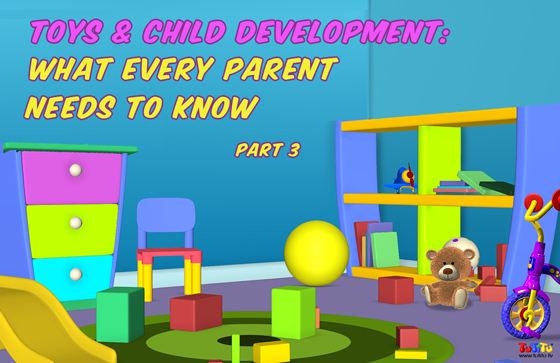Welcome back to our special series of articles about children’s toys and how they influence and benefit development! In the first two parts (you can read them here and here) we looked at anything from race cars to stuffed animals. For today’s third and final part we will discuss a few more classic toys and their importance for your toddler. As usual, every item is followed by a relevant video from TuTiTu Toys – a series of 3D animation videos for kids!
Doll Stroller
Here’s yet another example for a toy that is equally beneficial for girls and boys. Though taking your pretend-baby for a stroll is considered to be in the realm of girlhood, it really is a good activity for everyone. The more obvious reason for that are motor skills: when children are perfecting their walking skills, it sometimes helps to have something to lean on. And even if they already are walking geniuses, pushing a stroller around is in itself a challenge worth mastering.
The second benefit is the fact of playing with the baby and its stroller. This is classic pretend play, in which the toddlers get to act out what they see around them at home. It’s an opportunity to express themselves through play and to identify with their parents. It’s also a chance to work on some useful anatomy vocabulary and to teach basic concepts about parts of the body (or in the stroller’s case, vehicle vocabulary).
Animal Puppet Theater
Just like playing with a doll and stroller, the puppet theater can be a great outlet for self-expression through pretend play. You and your child can choose different characters to identify with and make up names and stories for them. You can then interact with your kid as ‘someone else’, which really helps bring out both sides’ creativity and imagination.
An even better idea is to go for an animal-themed puppet theater. This way you get the added dimension of teaching the toddler about the natural world. You can teach animal vocabulary, animal sounds and more. You can also help them learn some basic concepts using wh questions: Where is the cow? Which animal makes this or that sound? And so on.
Finally, a puppet theater can help with the development of fine motor skills, as it takes some precision and accuracy to move about the animals in a smooth way. You can help your child practice these skills by giving specific, gradually more difficult instructions, such as moving the puppet around to a certain spot.
Trampoline
Physical play is not only fun, it’s important! As every parent knows, it’s good to have an outlet for high energy. A trampoline gives your child that outlet (and then some), and also lets them exercise in an enjoyable way. There are plenty of motor skills being used and developed here – proprioception is practiced, as is balance. If you add music in the background, you can also work on coordination: jumping with the beat, for instance.
A trampoline can also be used to teach the child basic concepts such as high VS low and above VS under, as well as relevant vocabulary regarding physics and anatomy. When your toddler is tired of jumping on it him or herself, you can play with science experiments and try to bounce different objects on the trampoline. Discover together the connection between the weight of the object and its ability to bounce back, between elasticity and the height the object can reach and more.
Previously in the series: Part 1 & Part 2
And with this skip and hop we come to the end of our series about different toys and their benefits for your child’s development. We hope you enjoyed it and learned something!
Any toys that we missed? Tell us in the comments and SHARE on Facebook so others can comment too!

